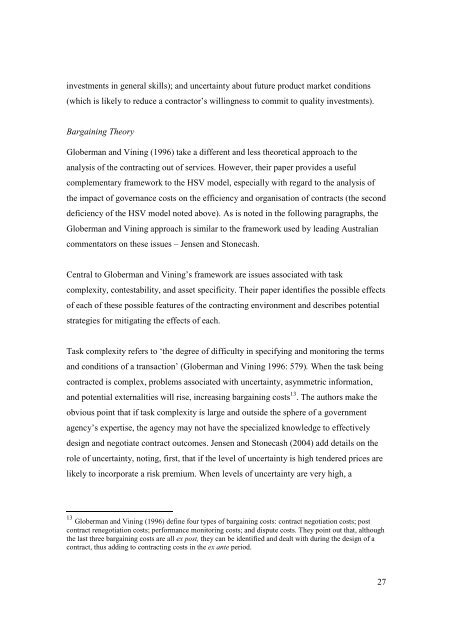Multi Outcome Construction Policy (final report)
Multi Outcome Construction Policy (final report)
Multi Outcome Construction Policy (final report)
Create successful ePaper yourself
Turn your PDF publications into a flip-book with our unique Google optimized e-Paper software.
investments in general skills); and uncertainty about future product market conditions(which is likely to reduce a contractor’s willingness to commit to quality investments).Bargaining TheoryGloberman and Vining (1996) take a different and less theoretical approach to theanalysis of the contracting out of services. However, their paper provides a usefulcomplementary framework to the HSV model, especially with regard to the analysis ofthe impact of governance costs on the efficiency and organisation of contracts (the seconddeficiency of the HSV model noted above). As is noted in the following paragraphs, theGloberman and Vining approach is similar to the framework used by leading Australiancommentators on these issues – Jensen and Stonecash.Central to Globerman and Vining’s framework are issues associated with taskcomplexity, contestability, and asset specificity. Their paper identifies the possible effectsof each of these possible features of the contracting environment and describes potentialstrategies for mitigating the effects of each.Task complexity refers to ‘the degree of difficulty in specifying and monitoring the termsand conditions of a transaction’ (Globerman and Vining 1996: 579). When the task beingcontracted is complex, problems associated with uncertainty, asymmetric information,and potential externalities will rise, increasing bargaining costs 13 . The authors make theobvious point that if task complexity is large and outside the sphere of a governmentagency’s expertise, the agency may not have the specialized knowledge to effectivelydesign and negotiate contract outcomes. Jensen and Stonecash (2004) add details on therole of uncertainty, noting, first, that if the level of uncertainty is high tendered prices arelikely to incorporate a risk premium. When levels of uncertainty are very high, a13 Globerman and Vining (1996) define four types of bargaining costs: contract negotiation costs; postcontract renegotiation costs; performance monitoring costs; and dispute costs. They point out that, althoughthe last three bargaining costs are all ex post, they can be identified and dealt with during the design of acontract, thus adding to contracting costs in the ex ante period.27
















